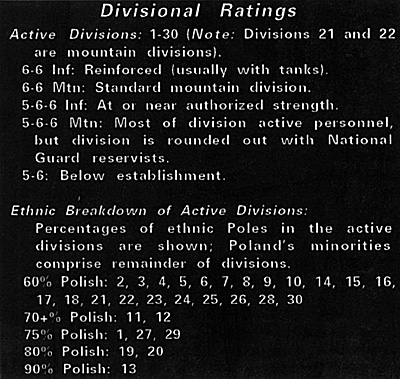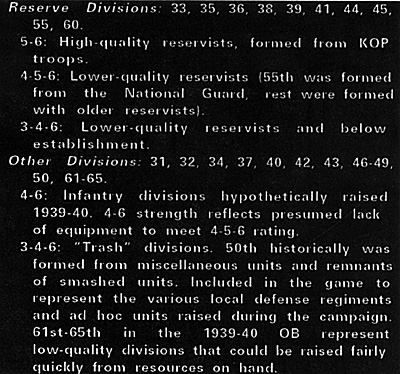 The backbone of the Polish Army was the infantry
division. A Polish infantry division typically had about 14-
16,000 men, organized in three infantry regiments (each of
three battalions), one artillery regiment (of 3-4 battalions,
including 1-2 75mm gun battalions), and smaller supporting
units (including battalions or companies of engineers, AA
guns, AT guns, bicyclists, machine gunners, and even
tankettes). In theory, every division was supposed to have a
full complement of supporting arms, including a tank
company, but in reality many did not.
The backbone of the Polish Army was the infantry
division. A Polish infantry division typically had about 14-
16,000 men, organized in three infantry regiments (each of
three battalions), one artillery regiment (of 3-4 battalions,
including 1-2 75mm gun battalions), and smaller supporting
units (including battalions or companies of engineers, AA
guns, AT guns, bicyclists, machine gunners, and even
tankettes). In theory, every division was supposed to have a
full complement of supporting arms, including a tank
company, but in reality many did not.
The first three infantry divisions were "legion" divisions. They traced their origins to the Pilsudski Legion of World War I. The legion fought with distinction in the Russo-Polish War of 1920. In 1939, however, "legion" was only an honorary title for these divisions and did not signify that they were any better than the other active divisions.
The two mountain divisions were organized similar to the infantry divisions, with three mountain regiments plus an artillery regiment. The artillery comprised regular field guns, not mountain guns. (in the game, these divisions have a 6-MP movement allowance because of the lesser mobility of the artillery-mountain troops in Europa usually have 8-MP movement allowances.)
Cavalry
In many ways, if the infantry divisions were the backbone of the Polish Army, the cavalry was its heart. Historically, Poland was renown for having excellent cavalry. For instance, in the Russo-Polish War of 1920, the cavalry performed excellent service, through its high morale and mobility.
By 1939, however, conditions had changed: motorized troops were much more mobile than cavalry, and tanks had vastly more firepower and shock value. The Poles knew this. (Despite German propaganda claims, Polish cavalry did not charge German panzers in 1939. In the evening of 1 September, elements of the Pomorska Cavalry Brigade surprised and charged an infantry battalion of the German- 20th Motorized Infantry Division, inflicting heavy casualties on it. German armored cars then arrived on the scene and drove off the cavalry.
When war correspondents visited the scene of the battle the next day, the Germans turned what could have been an embarassing incident into a propaganda victory by telling the reporters the Polish cavalry had charged and been decimated by German tanks.) Further, Poland was already in the process of dehorsing some of its cavalry brigades, converting them into mechanized brigades of motorized troops and tanks. Poland's resources, however, were inadequate to build a large motorized force in a short period of time.
Cavalry brigades came in two types: those with three cavalry regiments (shown at 3-8 in the game), and those with four cavalry regiments (shown at 4-3-8). (The Wolkowyska Brigade, shown at 2-8, was an exception, with only two regiments and few or no supporting elements.) Each brigade had an artillery battalion, an armored group, a bicycle (or rifle) battalion, and often antiaircraft and engineer elements. (Some bicycle battalions operated independently or with infantry divisions, but all are included in the brigades for convenience.) All told, a brigade had a strength of 6-7,000 men.
Polish cavalry regiments, both in the brigades and independent, were small when compared to the infantry: more the size of an infantry battalion than an infantry regiment. Their small size was made up by their elite qualities, as the cavalry had the pick of the Army's manpower and resources. To reflect the cavalry's qualities and abilities, Polish cavalry brigades with three or four regiments have zones of control in First to Fight.
Poland had two mechanized brigades at the start of the war. Earlier in 1939, the Poles had broken up a four-regiment cavalry brigade, converted the regiments into motorized rifle regiments, and used them to form two mechanized brigades. (Although officially motorized rifle "regiments," their cavalry regiment origin meant they were effectively battalions, not regiments.) Each mechanized brigade had two motorized rifle regiments, one tank battalion, and various supporting companies.
Frontier Defense Corps
Along with the cavalry, Poland had another high-quality force, the Frontier Defense Corps (Korpus Ochrony Pogranicza, or KOP). The KOP was formed after the Russo-Polish War, serving as border guards along the Soviet border and as security forces against Poland's Ukrainian minority. (Later, when Slovakia became an independent and pro-German state, the KOP guarded the Slovakian border as well.)
In peacetime, the KOP was maintained on a high state of readiness, with select personnel. Upon mobilization, KOP troops formed many regular Army units:
- 4x infantry division HQs (33, 35, 36, 38)
3x mountain brigade HQs (1, 2, 3)
12x infantry regiment HQs (3 per division)
34x infantry battalions (3 per regiment)
12x cavalry squadrons (formed in 3x regiments: Grodno, Wschod, and Zachod)
2x light artillery battalions
After mobilization, remaining KOP elements formed seven regiments: Baranowicze, Glebokie, Podole, Rowne, Samy, Wilejka, and Wilno.
National Guard
The last large branch of the Army was the National Guard (Obrona Narodowa). The National Guard was formed in 1936-37 to bolster the strength of the regular Army on mobilization. In 1939, the National Guard had 82 battalions divided into five types (four types of infantry battalions ranging from weak static battalions to battalions nearly equivalent to active infantry battalions, plus one type of machine gun battalion).
 On mobilization, National Guard
units formed or rounded out active and reserve units (21st
and 55th Divisions; 1st, 2nd, 3rd Mountain Brigades) as well
as forming several National Guard brigades. (Some National
Guard "half brigades" also existed, but these have been
consolidated with the full brigades in the game.)
On mobilization, National Guard
units formed or rounded out active and reserve units (21st
and 55th Divisions; 1st, 2nd, 3rd Mountain Brigades) as well
as forming several National Guard brigades. (Some National
Guard "half brigades" also existed, but these have been
consolidated with the full brigades in the game.)
Independent artillery regiments and brigades typically contained two or three battalions of 105mm and 155mm howitzers, together with other guns and howitzers with calibers of 75mm, 100mm, and 120mm. For convenience, the independent artillery is factored into these regiments and brigades. In actuality, the Poles operated various artillery battalions independently.
The 1-2-8 antitank brigade is a composite unit of three independent antitank companies.
The 1-R artillery battalions are armored trains. As with the cavalry, armored trains had performed well under the conditions of the Russo-Polish War. Poland therefore maintained ten armored trains divided into two groups. Each group had approximately 16 guns, of 75-100mm calibers, plus supporting troops. (The "armored" in "armored trains" meant the trains were physically armored and not that they had armored effects the same as tanks. Operationally, they were used for gunfire support of troops, and hence they are depicted as artillery in the game.)
Armor
Poland had a domestic tank industry and also imported British and French tanks. The TK and the improved TKS were 2-man tankettes. Foreign tanks included the obsolete French FT-17 (of World War I vintage), the British Vickers "E" tank, and the more- modern French R-35 tank. The Vickers "E" tank, purchased in 1931, served as the model for the Polish 7TPdw tank, produced in 1935, and the later 7TPjw, which was roughly equivalent to a German Panzer III.
The Polish tank industry was quite active in 1939, undergoing expansion to meet the Army's equipment needs while continuing to design new models. In 1939, prototypes for the 1OTP, a fast "cavalry" tank, and the 4TP, a 20mm-gun replacement for the TK/TKS, existed.
The two 1-8 tank battalions (1, 2) are equipped with 7TPjw tanks.
The two 1-6 tank battalions (21, 22) are equipped with French R-35 tanks. The 21st was forming with 50 tanks delivered from France via Romania. It was not completely operational at the start of the war and scooted back into Romania to avoid capture by the Germans. The 22nd would have been formed from the next delivery of R-35 tanks.
The 1-0-5 tank battalion is a composite unit of the three FT-17 tank companies, with a total of 60 tanks. The 1-8 light armored brigades (1 GP, 2 GP) are amalgamations of tankette companies.
Eighteen infantry divisions each had a tank company of 13 TK/TKS tankettes.
Each three or four regiment cavalry brigade had an armored group with 13 TK/TKS tankettes and 8 armored cars.
Each mechanized brigade had two TKS companies and one Vickers company.
The fortress brigades in the game are amalgamations of all sorts of small units: fortress detachments with infantry battalions, independent artillery battalions, machine gun companies, engineer companies, and construction troops.
The coastal region of the Polish corridor contained a hodge-podge of defensive forces. The 1st and 2nd Morska Regiments are ostensibly full marines, but evidence is lacking on their actual marine capabilities. They are thus shown as infantry, with hypothetical upgrades to full marines in 1940. The 2-3-4 naval troops brigade is a composite of independent, reserve, and ad hoc units in the coastal region.
Poland was weak in supporting forces, such as antiaircraft and engineers. Most AA guns were used for static air defense, although a few units were with the field forces. Independent engineers were concentrated in a few battalions-insufficient for Poland's needs in case of a protracted campaign. The 1939-40 OB presumes that Poland would remedy this lack over time. The 0-2-5 construction brigade is an amalgamation of numerous independent construction companies.
Inside Europa First to Fight Designer's Notes Part III: Poland [Europa 25]
- Introduction and Strategic Situation
Defense in Depth Plan vs. Actual Polish Plan
Orders of Battle: Army
Orders of Battle: Air Force
Orders of Battle: Navy
Table 1: 1939 Polish Tanks and Armored Cars
Table 2: Polish Aircraft
Inside Europa First to Fight Designer's Notes Part II, Section B Germany [Europa 24]
- German Army Divisions and Panzer Troops
Mountain Troops and Infantry
Cavalry, Artillery, and Engineer/Construction Troops
Security Troops
The Replacement Army
Luftwaffe
Kriegsmarine
Brandenburgers
SS and SA
Table 1: 1939 German Tanks
Table 2: 1939 German Divisions: Authorized Organizations
Table 3: German Divisions: Authorized Strengths
Table 4: German Aircraft
Inside Europa First to Fight Designer's Notes Part II, Section A Germany [Europa 23]
- Introduction
Army Re-armament and Manpower
Strategic Situation
Germany-Allies Strength Comparison
German High Command and the Government
Volksdeutsch Resettlement 1939-1942
The Wehrkreis System
Frontier Defenses and Border Regt Commands
Back to Europa Number 25 Table of Contents
Back to Europa List of Issues
Back to MagWeb Master Magazine List
© Copyright 1992 by GR/D
This article appears in MagWeb.com (Magazine Web) on the Internet World Wide Web. Other articles from military history and related magazines are available at http://www.magweb.com